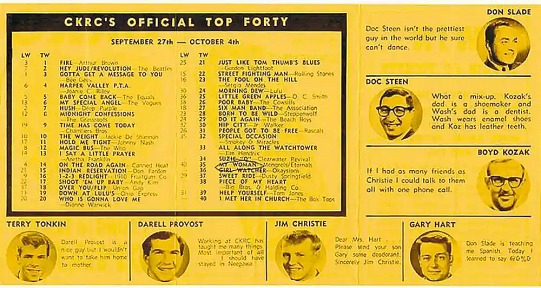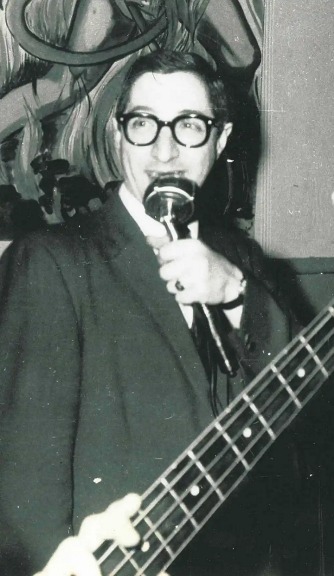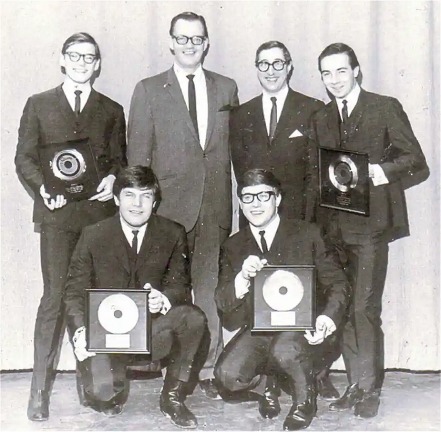By John Einarson
Ref: Winnipeg Free Press ~ Oct. 13, 2013
www.hillmanweb.com/chadallan/doc.html
Hey there, time traveller!
This article was published, so information in it may no longer be current.
https://www.winnipegfreepress.com/local/2013/10/13/the-doc-is-in
Back then, radio broadcasters were larger-than-life personalities.
“Deejay was a derogatory term to us,” states former CKRC broadcaster Boyd Kozak. “Anyone can play a record. We were broadcasters and encouraged to be ourselves on air.” Boyd met Doc when he signed on with CKRC in 1963. “He was just a happy, down-to-earth guy,” he recalls. “This business has its share of egos, but Doc was genuine. There was nothing phoney about him.”

Steen compiled the CKRC Young At Heart chart every week with great
care.
Born and raised in Winnipeg, Irving ‘Doc’ Steen’s academic goal was hijacked by a love for radio.
“My earliest recollection of Doc goes back to before he was ‘Doc’,” recalls Harry Taylor, who also worked at CKRC back in the ’60s. “During my childhood, I lived on Kate Street just off Notre Dame. On the corner was Gold’s Pharmacy. This would be in the mid to late ’40s. I remember a young pharmacy student was hired while still attending classes at the U of M. That was Irv Steen. He used to make me cough medicine at the pharmacy. To help pay for his studies, he also worked as a nighttime announcer at CJOB, where he picked up the nickname ‘Doc’ because of his field of study. Eventually, his radio career took centre stage to the benefit of us all.” After a stint on a CKGM in Montreal, Doc returned to Winnipeg. “He came to CKRC in the early ’60s so I got to work with my pharmacist.”
Taylor continues: “Doc drove the smallest car I had ever seen, a Nash Metropolitan. We used to tease him that he should get another one for the other foot.”
As music director, Doc compiled the weekly CKRC Young At Heart record charts.
“He took it very seriously,” notes Boyd. “It was really important to the station, but was not easy to do. He had to call the record stores and check out all the requests the station received that week.”
Perhaps no other radio personality had a greater impact on the local music scene than Steen. He promoted bands and hosted dances at the community clubs.
“We all agreed that if we were going into the rock ‘n’ roll thing,” Doc recalled in a 1986 interview with me, “we had to recognize and promote the local rock ‘n’ roll groups in our city. I guess for three or four years there wasn’t a Friday or a Saturday night that I wasn’t out at the community clubs. I enjoyed working with the bands.”
And the bands enjoyed working with Doc.

Doc Steen handles emceeing duties at a dance featuring the Crescendos circa 1965.
“He looked kind of square and was older than us but we really got along well with him,” the Crescendos’ Glenn MacRae remembers. “What he did for us on his radio show was far more than the other guys did. Doc made it a personal thing between himself and the band. He made jokes about us on air. He worked with other bands too, but he always maintained a sense of loyalty to us. Guys like Doc and the other deejays made the bands into local stars. I don’t know if it was a unique thing to Winnipeg but it was something special. They made us celebrities. It was a reciprocal relationship because it benefitted the radio station by connecting with the teen scene.”
Doc’s vast knowledge of music was impressive.
“Doc was emceeing one of our dances and asked us what our next song was. We told him Walking The Dog,” the Mongrels’ John MacInnes remembers. “He went up to the microphone and introduced it as an old Rufus Thomas song. We were teenagers and thought it was by the Rolling Stones because we learned it off their album.”
Doc arranged for the Crescendos to rehearse at the station and gave them 45s that were deemed unsuited to the station’s Top 40 format.
“He would give us records he thought might suit our band,” says MacRae. “That’s how we found Gloria and added it to our sets before anyone had heard it.”
Doc was also a mentor to others. “My very first radio visit as a promo guy was to Doc,” recalls Ken Bain. “I told him that I’d never done this before but I was willing to learn. Doc replied that if I was willing to listen then he would teach me how to pitch songs to radio. Every week, he would take the time to explain to me how the record guy/radio relationship worked. He loved music and he was very patient, understanding and knowledgeable.”
Later, when Doc moved over to fledgling CITI FM, he continued to encourage young broadcasters.
“Doc was older than the rest of us but he was in charge
of Musicology, an hour-long feature that ran every day on one artist,”
recalls Tom Milroy. “I did one for Doc on Alice Cooper, and he thought
it was good and so it went to air. To get approval from one of the radio
announcers I grew up listening to was pretty special and Doc Steen was
a pretty special guy.”
The Guess Who pose with Bob Burns and Doc Steen (back,
second from right) in 1965. pose with
Retiring to Vancouver in 1987, Doc later moved to Saskatoon, where his wife Anne accepted a federal government posting. He passed away on Sept. 8, 2004. His son Jerry became a radio broadcaster in Calgary.
“There was nobody I know in the broadcasting business who could ever say anything negative about Doc Steen,” says Boyd Kozak. “Everyone loved him.”

The Guess Who pose with Bob Burns and Doc Steen (back, second from
right) in 1965.
Join John Einarson for My Generation Saturday mornings from 10 am to noon on UMFM 101.5.
Born and raised in Winnipeg, music historian John Einarson is an acclaimed musicologist, broadcaster, educator, and author of 14 music biographies published worldwide.